Improve your pruning with 10 practical Great Dixter tips
Pruning is the backbone of a brilliant garden.
And February is pruning time at Great Dixter. I was invited to join Great Dixter’s Rachael Dodd on the new ‘Behind the Scenes’ afternoon series. In just two hours, I learned a great deal about what to do in my own garden.

‘There’s so much to see at this time of year,’ says Rachael. Which is not what people normally say in gardens in February – but it’s true when you’re finding out how to improve your own garden.
Great Dixter considers itself a ‘home’ garden. In spite of the horticultural students from all over the world, the intensively worked beds and the globally famous Long Border, it is still gardened in a very domestic way. And going round a garden with someone who knows it really well teaches you about gardening in a completely different way from wandering around on your own.
Think about why you’re pruning a particular plant
‘The only two things you need to know about pruning is when the plant flowers and why you’re pruning it,’ says Rachael.
Take Cotinus coggyria, for example, or smoke-bush. It is pruned in two different ways at Great Dixter. It flowers on last year’s wood, but the foliage is more gloriously copper-purple on new wood. So some cotinus are chopped hard back, so that they have lots of glorious blazing leaves (but few or no flowers).
Other cotinus shrubs are pruned by taking lengths out – usually the older or weaker stems – thereby leaving two-year old wood to blossom. The new wood will become next year’s smoky-puff flowers.

Our Cotinus Coggyria ‘Grace’ in autumn 2015. We had it hard-pruned that year and the new foliage was magnificent, but there were fewer flowers than usual.
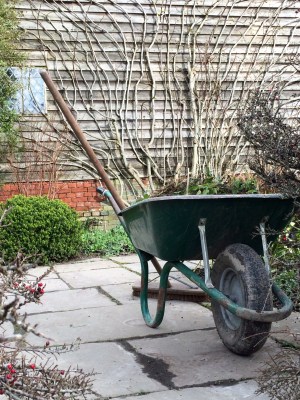
The fig in Great Dixter’s Barn Garden is also pruned for its foliage – sacrificing its harvest of figs. Christopher Lloyd used to sacrifice figs only one year in three, but now the shape and foliage are more important than the fruit.
Think about shape when you’re pruning
I have always religiously chopped my cornus down to within a few inches of the ground, because that’s what the books told me to do. At Great Dixter, however, even cornus is given some shape by ‘stepping’ the heights at which the cornus is pruned. It’s left a little longer at the middle and at the back, and a little shorter at the sides and the front.

Cornus ‘Midwinter Fire’ is a splash of colour amongst the evergreens at Great Dixter.
What height do you want your flowers to be?
Most pruning advice tells you how far back to prune a particular plant, but you don’t always have to go by the book.
‘We keep our shrub roses in the Long Border quite tall,’ explains Rachael. ‘Because there’s a lot else going on in the border. So the roses stand clear of what’s going on beneath them.’
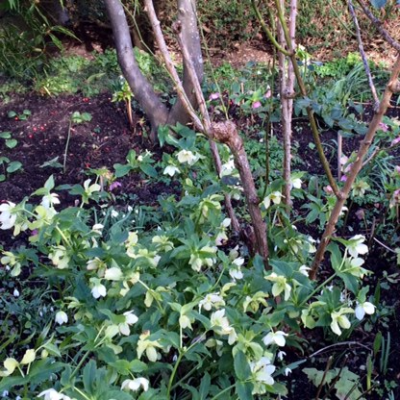
This shrub rose in the Long Border is left tall when it’s pruned. It’s underplanted with hellebores and snowdrops.
Some plants just need a simple clip
Plants like box or osmanthus delavyi just need to be clipped into shape all over. Clip the osmanthus with shears after it flowers in spring. ‘We clip ivy like this with shears, too,’ says Rachael.
Others look better with lengths taken out
Taking out lengths of stem from the centre of a plant gives it a soft, airy shape. This is how Euonymus fortunei ‘Silver Queen’ is pruned at Dixter. For more about pruning for an airy shape, see my post How to Have Privacy AND Light in Your Garden.)
Now is a good time for drastic action
If you’re reading this in February and have a plant or tree that has got out of hand, now is the time to tackle it, says Rachael. We saw a couple of trees and shrubs that had a half to a third of their bulk taken out.
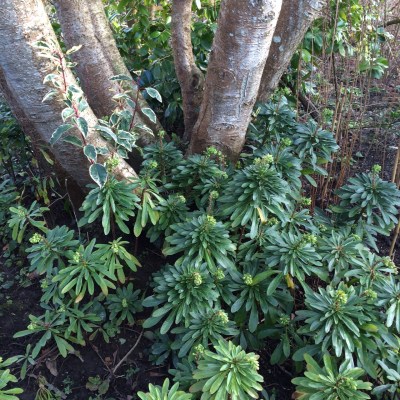
This Portuguese laurel dominated its area of the garden until it was drastically thinned last February. Now it’s light enough for euphorbia to self-seed itself around its base.
How to prune bamboo
If you’re looking for that transparent effect, then you need to thin bamboo out, taking away older stems, says Rachael. ‘Fergus doesn’t allow us to strip off the lower leaves -he calls it a “mullet cut”.’ While you’re taking out stems, keep looking at what the removal of each stem is doing to the shape at the top. If your bamboo is a spreader, dig round it every year to stop it from taking over the garden.
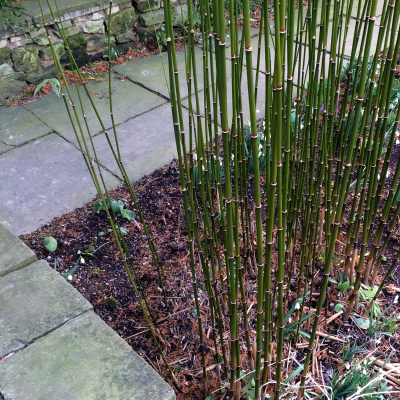
‘Naked bamboo’ at Great Dixter.
Use your prunings!
Prunings can be used for a number of things. Bamboo poles are used at Great Dixter to mark out the beds. ‘That’s partly because we have so many people gardening here,’ says Rachael. ‘But it’s also to mark out where the perennials are. We can then allow self-seeders – and plant alliums – in the ‘corridors’ between the perennials. It’s a useful way of remembering where everything is when it’s underground.
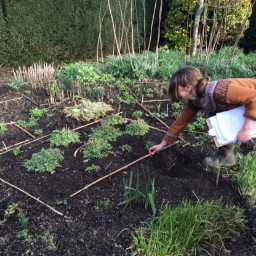
Rachael pointing out the bamboo poles that mark out where the perennials grow.
And now is also a good time to take cuttings from your prunings. ‘We take cuttings from cornus, elder, hydrangeas, willow and roses at this time of year. Twigs about the width of a pencil are best,’ says Rachael. ‘Take off all but the top few leaves and plunge into a pot with a mix of potting compost and sand. Don’t let it dry out. Not all will take, but it’s worth a go.’
Tree prunings, such as hazel, willow and birch, are used later in the year for plant supports.
Feed your plants after pruning
They use blood, fish and bone at Great Dixter, forked gently in around the base of the plant (avoiding the underpants…see below).
Bonus tip:
Plant hellebores, snowdrops and primroses under deciduous shrubs to give great colour at this time of year without taking up space needed by the perennials.
When I was emailing my pix to my computer, predictive text kept changing ‘trees under-planting’ to ‘trees underpants.’ Which seems appropriate, although ‘lingerie’ might be a more attractive term.
All over Dixter, bare roots had frilly blooms as underwear, most of which have clumped up or self-seeded because they’re not disturbed by annual planting or work on perennials. ‘Although you do have to be a bit careful when pruning,’ says Rachael. ‘You don’t want to step on them.’
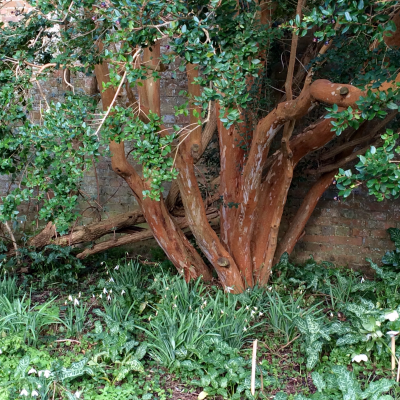
Chilean myrtle at with its ‘underpants’ of snowdrops…
Pruning is more than just cutting back
Pruning is so much more than just cutting back…It takes experience to ‘read’ a garden. That’s why going round with Rachael ‘behind the scenes’ is so illuminating.
You don’t just see how things are done at Dixter, but also how you could do them in your own garden. Great Dixter is a garden where everything is questioned, all the time (for more Great Dixter tips, see my post 9 Things to Do Differently In The Garden)
After the garden tour, we warmed up with tea and cake, and looked at slides and were given a plant list.

Rachael also gave a practical demonstration on how to prune hydrangeas…
The rest of the group ranged from amateurs to garden professionals topping up their knowledge. If ‘Behind the Scenes’ can be that fascinating in February, think how much you might get out of it in the rest of the year. I can warmly recommend that you book into one of the once-a-month sessions now.

The group is quite small – only about a dozen of us, so plenty of chance for questions about what to do in your own garden.
If you’ve found this useful, do share, using the buttons below. Thank you!
Pin for reference

























Really interesting (and rather nostalgic – I was born just up the road at Merriment Farm)!
One quick Q: in what season should I hard hard prune my Cotinus Coggygria?
Thank you – prune the cotinus in late winter or early spring.
Great explanation, I remember when I was just getting into gardening how hard was to understand what actually pruning does and why we do it anyway. Rachael put it simply and comprehensible. Lovely read. :)
Thank you! Great Dixter is such a good garden to visit.
Really interesting tips on pruning, particularly as we have a tree-sized Cotinus that needs a drastic hair cut. I don’t need much of an excuse for a visit to Great Dixter, but the ‘Behind the Scenes’ events sound really useful.
Our tree-sized cotinus really loved its haircut – I got Posy Gentles to do it, and she does ‘transparent pruning’, where you take lengths out. Cut out branches where they intersect with main branches or the trunk – don’t chop halfway across a branch because that just makes it bush out at that point and get even more clumpy-looking.